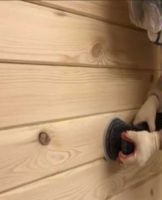Fabric painting techniques and what colors to choose, a master class for beginners
Fabric painting is considered a popular technology that makes it possible to create exclusive items from the most ordinary garments. The creative process of drawing turns out to be very interesting. This is why many people turn their hobby into a source of income. It is allowed to paint fabrics with acrylic paints or use other substances. It requires artistic skills. If they are not there, it is allowed to use stencils.
Art painting on fabric - general idea
Handmade art painting is done with acrylic dyes, which are made on the basis of polymers. This means that the pigment does not penetrate the structure of the fibers, but covers them with a protective film. As a result, the structure becomes denser and loses its elasticity.
Products that have been coated with dyes become shiny and colorful. In addition, they acquire exclusivity. Another advantage of using acrylic is the waterproof effect.
The main advantages of these formulations are:
- varied assortment;
- availablity;
- safety of use;
- ease of application;
- drawings waterproof coating;
- ease of mixing dyes.
To fix the acrylic paint on the fabric, it must be dried. It is permissible to do this with a barely heated iron.
Varieties
There are many types of techniques for painting clothes and materials. Each of them has certain characteristics.
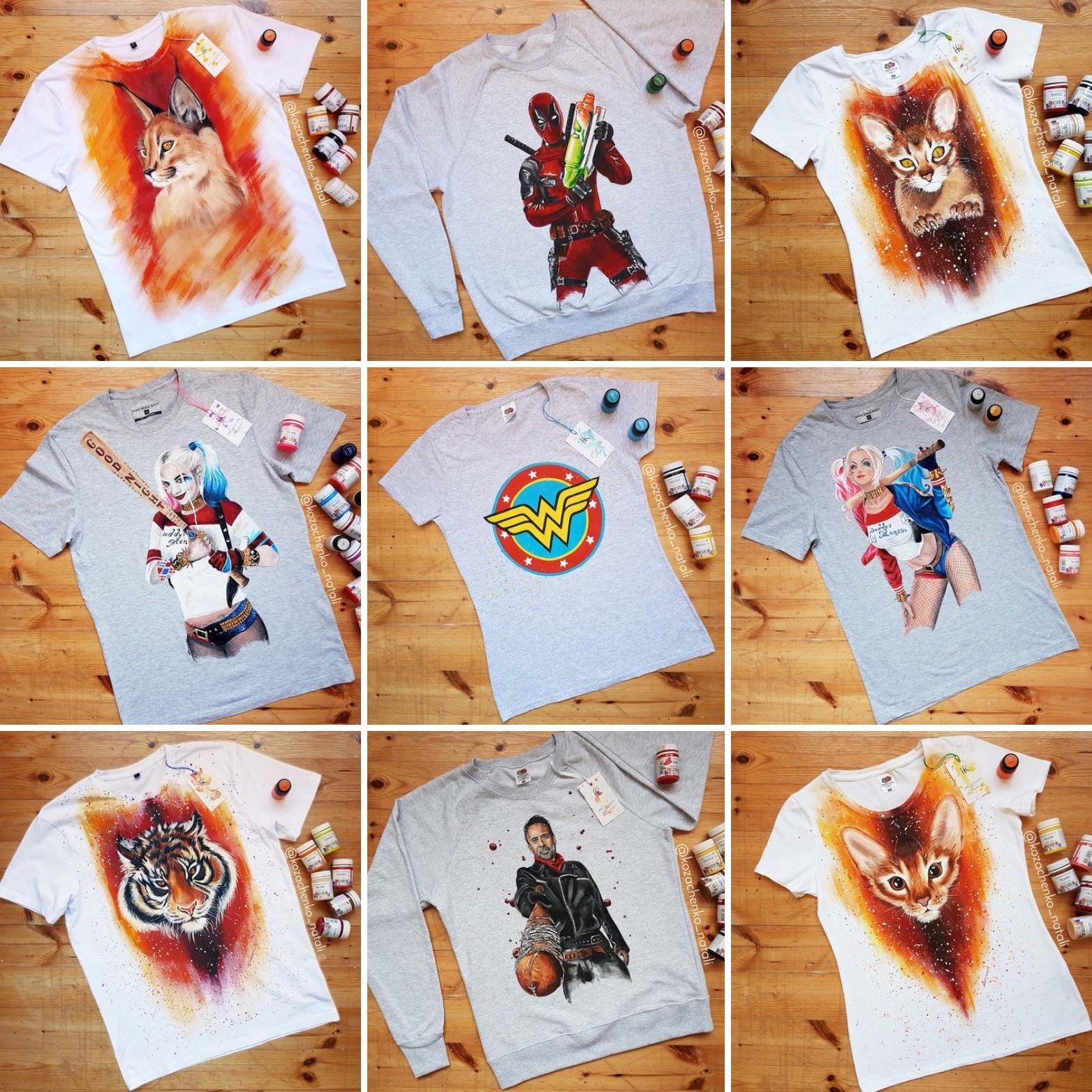
hot batik
This coloring method is performed using melted wax. This technique is considered one of the most difficult. Therefore, it is only used by professionals. Hot batik helps to create exquisite and colorful images. For this, unusual shades are used. This technique helps you maximize your imagination and gives you a wide field of experimentation.
cold batik
For this technique, special formulations are used that make the paints less fluid. A feature of cold batik is the creation of a light color outline. Staining is carried out from light to dark tones. Sometimes ready-made stencils are used to apply the substance.
Free painting
This technique is similar to a watercolor painting due to the soft gradations of the shades. With its help, it is possible to reveal the uniqueness and apply the author's handwriting. To apply a pattern to stretched fabric, use the same motions as when painting a canvas. To do this, make free brush strokes. The technique involves the choice of any image. To make the drawing more reliable, it is worth using resists.
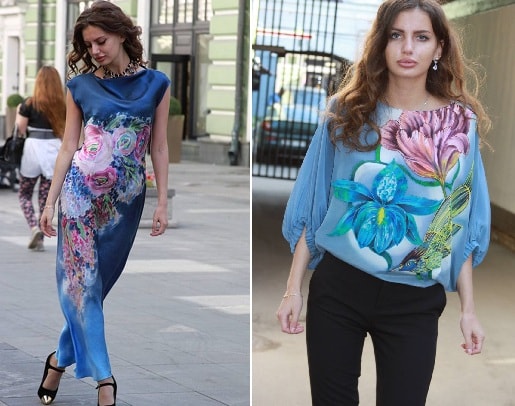
Free Watercolor Painting
This type of paint is based on the use of a saline solution. Special watercolor primers can also be used.To do this, the fabric should be pulled over the frame, soaked in aqueous saline solution or watercolor primer. After drying, the surface should be painted with paints.
The saline solution helps make the paint less fluid. Therefore, it allows you to apply them with free strokes. To complete the painting, you need to use the technique of watercolor painting. In this case, it is necessary to switch from light to dark tones and from the upper edges to the lower edges.
Free salt paint
To perform this type of painting, the T-shirt must be pulled over the frame and treated with liquid dyes. In this case, the master pours salt crystals in a specific order. They attract the dye and darken it. To make the result more spectacular, it is worth using salt crystals of different sizes.
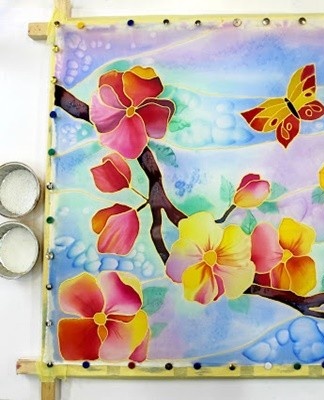
icing
It is a common technique that is often used in painting. It is also suitable for fabric painting. The method is based on a technique that consists of mixing the paints directly on the surface of the material. In addition, they should be layered on top of each other. It helps to change the hue. Transparent aniline dyes are ideal for this technique.
It is allowed to use glazing in any work. However, as a practice, an image of a stylized still life is suitable. It should include glasses, carafes or other utensils of the original form. In this case, the edges of the objects should overlap. As a result, it will be possible to see that mixing pink with blue will help to achieve a lilac tone, and a combination of a blue tint with yellow will give a green color.
First, you need to prepare a drawing and transfer it to the surface of the fabric. Then outline the contours with a redundant layer.Paint a specific object with a selected tint. An adjacent object must be painted in 2 steps. First, the dye should be applied to the main part, then to the area where it intersects with another object. In this way, it is necessary to apply stain until the whole still life is fully painted.
If an object seems too light, you need to apply another coat of stain. Particularly interesting and original effects can be achieved in the area of overlap of 2-3 objects.
At the end you need to paint the bottom. For this, it is recommended to use light and transparent shades. It is not worth connecting more than 3 colors for this. It is also not recommended to mix contrasting tones - blue with orange, red with green, yellow with purple. Combinations like this often lead to dirty tones - gray or brown.

Bandana
This technique is also called knotted batik. One of its varieties, the planga technique, was popular in India. For this, the unpainted fabric was covered with small knots in a certain pattern, and then tightly tied with a thread. After that, the material was dyed and the threads were removed. Thanks to this, it was possible to obtain a pattern consisting of white peas.
If necessary, the material was colored several times. For this, the craftsmen removed the old knots and added new ones. Dressing threads were removed from the dried material. However, the finished product has not been ironed. Thanks to this, it was possible to maintain the crumpled effect for a long time.
Today, nodular painting is called simple options. It can be a pattern in the form of one or more circles.When dyeing dry material, it will be possible to achieve a clean transition between the dye and the unpainted canvas. If the fabric is wet, smooth transitions are created.
Hidden reserve method
For painting fabrics, many additional techniques are used that help to accurately realize artistic ideas. At the same time, the masters pay special attention to creativity, and not to the peculiarities of technology.
The hidden reserve is to apply a transparent outline to the dried painted material. Then another color is poured into the outline - it should be darker than the background. After that, the silhouette of the drawing is made with a transparent resist. It is important to apply the resist without gaps, since it will be difficult to detect flaws.
After the contours have dried, you need to fill the drawing with a bright shade. Due to this, it is possible to obtain a drawing without white borders. The hidden reserve involves work on several floors. This technique is reminiscent of hot batik.
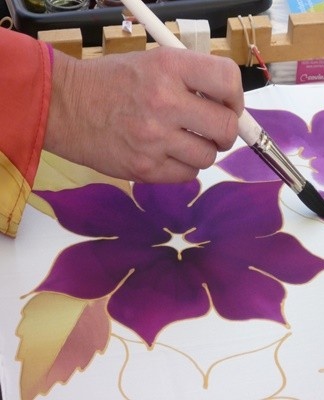
With an airbrush
This accessory is an upgraded spray bottle. It helps to spray fine particles of dye, which helps in creating silhouette images. By changing the angle of application of the paint, it is possible to achieve the desired degree of color saturation.
What paints are used
It is important for beginners to choose the right dyes and learn how to apply them. Gouache is rarely used in this case. For artistic painting, the following types of dyes are often used:
- Aniline paints. After completing their application, the pattern must be fixed with steam. It is quite difficult to do it yourself.To achieve the desired effect, it is worth having the appropriate skills and special devices. Many artisans use large water containers. However, it is better to use special autoclaves.
- Acrylic paints. They can be easily fixed with an iron. It is much easier to paint the fabric this way. This method is simple and affordable.
What kind of fabric and clothes can be painted
It is allowed to draw on a piece of fabric or apply dye to the finished product. The result of the work directly depends on the choice of material. Thick fabrics are best suited for applying acrylic - for this it is permissible to use linen, cotton and dense synthetics. Natural or artificial suede and leather are also good options.
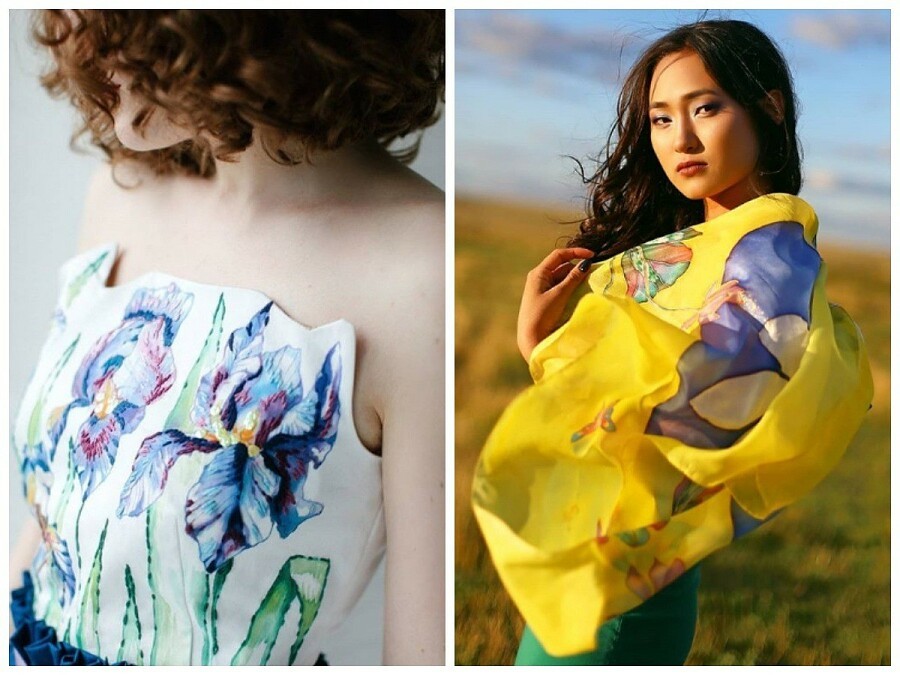
Saturated tones will look advantageous on light monochromatic materials. At the same time, light and thin prints go well with dark fabrics. This combination helps to make the design more expressive.
Detailed master class for beginners
To draw with an outline on a fabric, it is allowed to use different techniques. In this case, it is necessary to take into account the following characteristics:
- Mixing acrylic paints with water will reduce their adhesion to fabric fibers. Therefore, it is recommended to use branded thinners.
- An impenetrable base should be placed under the fabric to be dyed. It will protect the work surface.
- For work it is worth using brushes with artificial villi. It is also allowed to use sponges and rollers.
- Stencil designs involve the application of dye in multiple layers. Each subsequent coat should only be applied after the previous one has dried.
- After applying the dye, it must be fixed with a hot iron.This is done in a day.
Examples of painting clothes and knitwear
It is allowed to apply a variety of types of patterns to clothes and fabrics. Floral and geometric ornaments are very popular. It is also allowed to use images of people, animals, cartoon characters.
Artistic painting on fabric makes it possible to create unique and exclusive objects. For the successful application of the dye, it is important to strictly follow the technique of its application.


